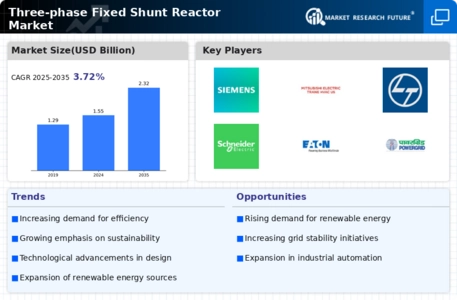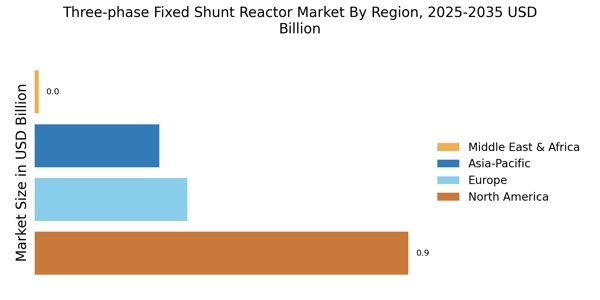Increasing Power Demand
The escalating demand for electricity across various sectors appears to be a primary driver for the Three-phase Fixed Shunt Reactor Market. As urbanization and industrialization continue to rise, the need for reliable power supply becomes paramount. This demand is reflected in the projected growth of the energy sector, with estimates indicating a compound annual growth rate of approximately 5% over the next decade. Consequently, utilities are increasingly investing in infrastructure to enhance grid stability and efficiency, which in turn propels the adoption of three-phase fixed shunt reactors. These reactors play a crucial role in managing reactive power, thereby ensuring voltage stability and reducing transmission losses. As a result, the market for three-phase fixed shunt reactors is likely to expand in tandem with the growing energy requirements.
Integration of Renewable Energy Sources
The integration of renewable energy sources into existing power grids is emerging as a significant driver for the Three-phase Fixed Shunt Reactor Market. As the share of renewables, such as wind and solar, increases, the need for effective reactive power management becomes more pronounced. These energy sources often introduce variability and can lead to voltage fluctuations, necessitating the use of three-phase fixed shunt reactors to stabilize the grid. Market data indicates that the share of renewables in the energy mix is expected to reach 30% by 2030, further emphasizing the need for reactive power solutions. Consequently, the demand for three-phase fixed shunt reactors is likely to rise as utilities seek to enhance grid reliability and accommodate the growing penetration of renewable energy.
Technological Innovations in Power Systems
Technological advancements in power system design and operation are likely to influence the Three-phase Fixed Shunt Reactor Market positively. Innovations such as smart grid technologies and advanced monitoring systems are enhancing the efficiency and effectiveness of reactive power management. These developments enable utilities to optimize the performance of three-phase fixed shunt reactors, thereby improving their operational reliability. Furthermore, the introduction of digital solutions for real-time monitoring and control is expected to drive the adoption of these reactors. As utilities increasingly embrace technology to enhance grid performance, the market for three-phase fixed shunt reactors is poised for growth, reflecting the ongoing evolution of power systems.
Regulatory Support for Reactive Power Management
Regulatory frameworks aimed at improving grid reliability and efficiency are likely to bolster the Three-phase Fixed Shunt Reactor Market. Governments and regulatory bodies are increasingly recognizing the importance of reactive power management in maintaining voltage levels and enhancing overall grid performance. Policies that mandate the installation of reactive power compensation devices, including three-phase fixed shunt reactors, are becoming more prevalent. For instance, certain regions have implemented standards that require utilities to maintain specific power factor levels, thereby incentivizing the adoption of these reactors. This regulatory support not only encourages investment in reactive power solutions but also aligns with broader energy efficiency goals, suggesting a favorable environment for the growth of the three-phase fixed shunt reactor market.
Growing Investment in Transmission Infrastructure
The increasing investment in transmission infrastructure is a notable driver for the Three-phase Fixed Shunt Reactor Market. As countries strive to modernize their electrical grids, substantial funding is being allocated to enhance transmission capabilities. This investment is crucial for accommodating the rising demand for electricity and integrating renewable energy sources. Market analysis suggests that the global investment in transmission infrastructure could exceed USD 100 billion by 2030. This surge in funding is likely to create opportunities for the deployment of three-phase fixed shunt reactors, which are essential for maintaining voltage stability and improving overall grid performance. As utilities prioritize infrastructure upgrades, the demand for these reactors is expected to grow correspondingly.


















Leave a Comment